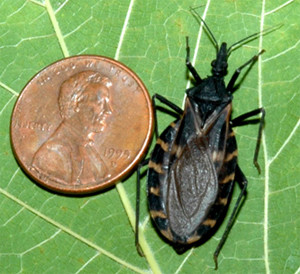Hello fellow readers,
Were you bitten by a Kissing Bug during Valentine’s? Chances are no -not that I don’t wish you love. You may recall Craig from Frelinghuysen, our comical guest, with his willows gone wild and fairy ring dilemmas. When Craig asked about Kissing Bugs I reminisced about Love Bug season while visiting the folks in Florida. Dear Mom would sweep thousands of the culprits from the temporary screen that protected the car engine from the mating critters. While Triatoma gerstaeckeri can also be called Love Bugs they’re not the same nemesis.
Turns out Kissing Bugs feed on blood from vertebrates, including humans, birds and reptiles. They’re nocturnal, hence active at night, and are fond of feeding around the lips and faces of unsuspecting prey. They’re about an inch long with a cone-shaped head. The species found in the United States are black or dark brown with orange, red, or yellow stripes around the border of their body. The heebie jeebie part is about half of them carry the parasite Trypanosoma cruzi in their feces which can cause Chagas’ disease, though the risk of infection here is rare. The bug defecates while feeding and should fecal matter get rubbed into the mucous of the eye, mouth or bite wound, the parasite can enter the body.

Triatoma gerstaeckeri next to a penny for scale. Photo courtesy S. Kjos. CDC website
The Center for Disease Control and Prevention (CDC) has tracked Kissing Bugs in 28 states with the largest concentration in the South; though the latest CDC bug occurrence map shows Pennsylvania as a Kissing Bug state and New Jersey as potentially so. The CDC estimates there are about 300,000 cases of Chagas in the United States, but most cases were contracted in other countries. Chagas is prevalent in Latin and South America where a different species of the blood suckers finds their way into homes. If infected most only experience flu-like symptoms, though Chagas can cause chronic conditions even death.
Craig’s thinks he came across Kissing Bugs in his office in the fall. ‘I’ve grown soft in my later years and let them walk around until they decided to leave. I didn’t realize they were eyeing me up for a meal and won’t be so kind this spring.’
Not so fast partner. There are lookalikes such as Assassin Bugs, Rasahus thoracicus, which are beneficial bugs feeding on insects including aphids, stink bugs, houseflies. Or the Wheel Bug, Arilus cristatus, that prey on squash bugs.
If you suspect a Kissing Bug, the CDC suggests you freeze it in water then take to your health department for testing. Maybe best to keep your Kissing Bug separate from your ice cube tray Craig. Garden dilemmas? askmarystone@gmail.com


